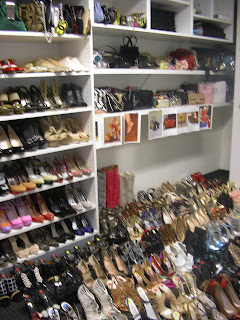 takes a stab at a current frienemy by letting all the models go home just before the show starts. Conse- quently, the frienemy and her cohorts get to model in the show.
takes a stab at a current frienemy by letting all the models go home just before the show starts. Conse- quently, the frienemy and her cohorts get to model in the show.Above: A model walking up the runway at Aurelio Costarella's Spring/Summer 2009
fashion show in New York's Bryant Park. Photographed by: Me on September 11, 2008
I use this as an example of a misconception because there is absolutely no way a group of normal girls would fit in clothing made specifically for models (even if they were a size 2). The first time I saw a group of models in the office, I knew immediately on site that they were models. They are so tall and slender, I felt like they were beautiful giants that could reach down with their long arms and pluck me from the ground at any moment.
"Model-casting agents have showed initial interest but have repeatedly told Tatiana to lose 10 to 15 pounds to reach the 34-24-34 measurements they seek. Her waist is 28 inches and her hips are 36." -Christina Binkley in The Wall Street Journal on 6'2" aspiring model Tatiana Stewart.
While this is an example of one small misconception, I feel like many people have varying other false perceptions about fashion shows. I was lucky enough to get to attend a couple.
During New York fashion week, I was able to attend shows for Chris Han and Aurelio Costarella. It was an incredible experience.
"Are you kidding? We get better access at Air Force One than KCD shows." - A newswire photographer, at the Diane von Furstenberg show as shared by Fashionista.
First of all, it is helpful to note that there are four main fashion weeks that each happen twice a year. The main fashion weeks are located in New York, London, Milan and Paris. One fashion week is held in each location for both Spring/Summer and Fall/Winter.
View Larger Map
New York fashion week is held in Bryant Park. Large white tents are set up that house the shows. Once everyone enters the tent they are greeted with small gifts (depending on the show) and bottled water. They take their seats or mill around and chat with friends. When the show is about the start, all the lights go out. People rush to their seats. After a few seconds, the lights come back up, the music starts and the first model heads down the runway. People are seated on either side of the runway with a large stand full of photographers at the end of the runway flashing away with their large zoom lenses. When one model reaches the end, the next model begins. Typically, 30-50 looks are shown and then all the models come out in a line with the designer at the end.
 The designer takes a bow and the show is over. It only lasts about 15 minutes, but it is one of the coolest and most indes- cribable things I have ever seen.
The designer takes a bow and the show is over. It only lasts about 15 minutes, but it is one of the coolest and most indes- cribable things I have ever seen.Above: A model walking down the runway at Aurelio Costarella's Spring/Summer 2009 fashion show in New York's Bryant Park. Photographed by: Me on September 11, 2008
Below: Style.com's YouTube coverage of the Lanvin Spring/Summer 2009 fashion show at Bryant Park.







